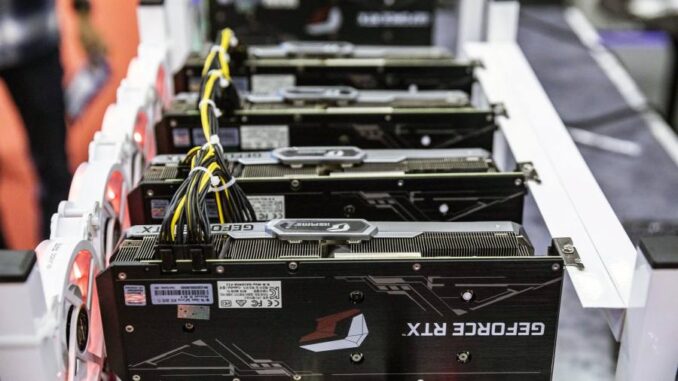
Ether crypto miners are looking to repurpose technology made obsolete by last month’s “Merge” for other energy-intensive activity, potentially blunting the crypto project’s effort to slash its carbon footprint.
Companies and small investors that lost out following the success of the Merge are turning to mining other cryptocurrencies, hosting services in the cloud and even heating their homes to make use of their equipment.
The Merge, one of the most ambitious projects in crypto history, transformed the running and upkeep of the popular Ethereum blockchain by moving from a “proof-of-work” system to one known as “proof of stake”.
That switch drastically slashed the amount of energy needed to mine new ether tokens and maintain the ledger that tracks all Ethereum deals. Co-founder Vitalik Buterin claimed the transition would cut worldwide electricity consumption by 0.2 per cent.
But that has left many investors who bet against the Merge happening with stacks of redundant IT equipment. Many are looking to repurpose their energy-intensive machines for other computing services. Ether miners use tech that contains graphics processing units (GPUs), computer chips that can handle high volumes of data and are more adaptable than bitcoin mining machines.
Large companies such as Hut 8 Mining and Hive Blockchain Technologies have said they will turn to cloud computing. “Tracking the consequences of the Merge becomes worse if you consider that graphics cards have uses outside of mining, like cloud computing, AI and gaming,” said Alex de Vries, founder of the Digiconomist crypto analytics site. “It could be near impossible to track.”
Many ether miners were ordinary consumers as it used less power than bitcoin. “There’s a huge retail base in Ethereum mining, because it’s much easier to run a GPU in your house than a bitcoin mining machine,” said Ethan Vera, chief operating officer of Luxor Technologies, a mining and analytics company.
Chris Kyle, director of marketing at Flexpool, a mutualised crypto mining group, is planning to use his 86 GPUs to heat his Vancouver home. The units are roughly the size of a computer keyboard, and graphics card temperatures can range between 40C and 90C.
“Now that it’s getting cold I’m going to turn them back on . . . all the energy you put in them gets turned into heat so it makes sense to just run my GPU instead of turning the heating on.”
Some are mining other energy-intensive cryptocurrencies. Around a fifth of the computing power that was devoted to mining the old Ethereum blockchain has been switched to alternative coins, such as Ethereum Classic, Ravencoin and Ergo.
However, the influx of new miners has increased competition, squeezing an industry already struggling with high energy costs. “It is extremely unlikely mining these coins is profitable anymore as margins will be squeezed to an extreme,” said James Check, a lead analyst at Glassnode, a blockchain data and intelligence company.
Others are waiting for a pick-up in prices. Jon Hartwig, a manufacturing engineer from Iowa, spends his evenings and weekends dusting and checking the wiring of his 600 GPUs.
Recommended
“A lot of miners are holding on to their gear . . . I’m going to sit on it and wait until the next thing that comes along,” he said.
Mark D’Aria, chief executive of Bitpro Consulting, which resells used mining equipment, said the volume of GPUs sold on the platform had risen 30 per cent in the month since the Merge, and prices had not fallen “as much as I thought they would”.
“More people are selling . . . but it has slowed a lot after those first two weeks. There are an enormous amount of graphic cards out there waiting for someone to figure out what to do with.”






Be the first to comment